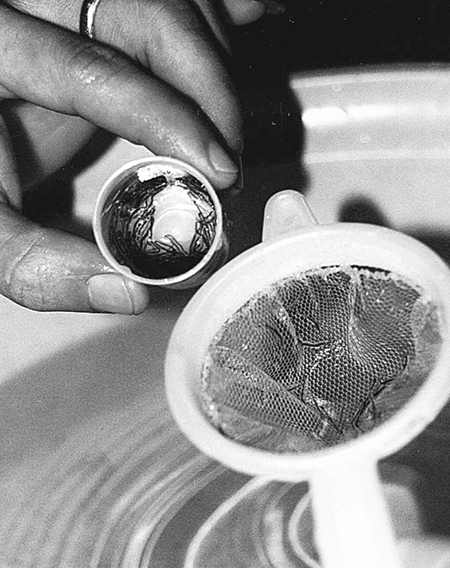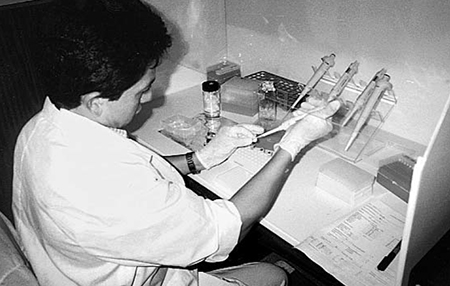Vaccines and good husbandry, sanitary practices are also crucial to prevent infectious diseases

Disease-related financial loss can be one of the highest costs of operation in aquaculture. These losses range from acute mortality due to disease outbreaks, to insidious, sub-acute infections that can decrease feed conversion rates, increase labor costs, and decrease carcass value at harvest.
Diagnostic monitoring and prevention are two of the most cost-effective means of avoiding the economic losses caused by pathogens. They are valuable management tools with which to make rapid, prudent management decisions. Over the past decade, the field of diagnostics has developed ever more-sensitive detection systems. There are many stages in the production cycle where such diagnostic tests are useful.
Testing broodstock
The first is in the screening of broodstock to prevent the potential spread of a pathogen from parent to offspring (vertical transmission). The most sensitive system available is desired if the goal is to establish a breeding population free of a specific pathogen.
Testing young animals
Routine diagnostic testing is also valuable in monitoring very young animals. These animals are usually segregated into groups that are raised in small tanks, ponds, or raceways; or further separated in individual, free-standing buildings, or rooms within a building. It is wise to periodically monitor these groups because if a sample from a tank comes up “hot,” reflecting an infection or increased level of the pathogen, you want to prevent the potential spread to other tanks that may occur through normal husbandry practices.
For example, if the people maintaining the facility come in contact with the infected tank and then go to other tanks to distribute feed or manipulate the system, they run the risk of spreading the pathogen throughout the facility. Or, as in many operations, animals from several tanks may be combined in large runs or bigger ponds and tanks as the animals grow. If one hot tank is combined with several clean tanks, all the animals can become infected.
Testing at stocking
Another critical point for testing is at the time of stocking. If you are purchasing animals to stock a grow-out facility, have them checked for the presence of pathogenic agents so you do not introduce them into your operation.
Stocking is typically a very stressful time for the animals. They are subjected to physical stress such as handling and transport, environmental stress such as different water temperature or salinity, and perhaps even physiological stress such as smoltification or molting. All of these will exacerbate an infection if it is present, and may induce increased shedding of the agent from infected animals.
Testing during grow-out

Routine testing during grow-out is also a good management practice. If it is determined very early in grow-out that the pathogen load is escalating dramatically, management may decide to eliminate the population, decontaminate, and restock.
This has the advantage that if you are producing a season- dependent aquatic species, you can still restock to take advantage of the weather, photoperiod, etc. Monitoring can also be a cost-saving measure, as you will not continue to feed a population of animals that will have a lower survival- to-market weight, or that is using the feed energy to combat the infection rather than gaining weight.
If, on the other hand, the pathogen load is increasing dramatically late in grow-out, the decision might be made to harvest early. Although top dollar might not be gained for the product, some value may be recouped in a situation where, if harvest was delayed, the entire crop might be lost.
The most difficult grow-out situation is where the pathogen load increases during the middle of grow-out. Even here, the earlier you detect an increase in pathogen load, the better your chances for obtaining successful treatments.
Early detection and action
Animals, like humans, stop eating when they become ill. Therefore, early application of medicated feeds is costeffective because the animals that need the antibiotic will still consume the feed, thereby reducing waste and cost. In addition, early medication decreases the amount of antibiotics required to obtain the desired effect.
Secondary infections
Even in the face of viral infections, secondary bacterial infection with such pathogens as Vibrio may be the ultimate insult. Here, too, the early administration of medicated feeds can be beneficial.
Also, by monitoring on a pond-by-pond basis, the farmer can apply therapeutants or targeted management changes only to the affected ponds, rather than a farm-wide approach that might be unnecessary and would be more costly. Other potential management interventions that can be taken in the face of increased pathogen load are the reduction of stocking density, administering of immunomodulators and improvements in nutrition and water quality.
Conclusion
Disease outbreaks significantly alter product quality and disrupt production schedules. To prevent and control these disease outbreaks, a broad-ranging, preventive-medicine approach is required, as in the poultry and swine industries.
An integral part of a preventive-medicine program is the use of diagnostic tests at strategic points in the production cycle. However, diagnostics alone will not win the battle against the spread of infectious diseases. The administration of effective vaccines (where available), as well as good husbandry and sanitary practices, must also be implemented as components of a preventive-medicine approach.
(Editor’s Note: This article was originally published in the December 2000 print edition of the Global Aquaculture Advocate.)
Now that you've finished reading the article ...
… we hope you’ll consider supporting our mission to document the evolution of the global aquaculture industry and share our vast network of contributors’ expansive knowledge every week.
By becoming a Global Seafood Alliance member, you’re ensuring that all of the pre-competitive work we do through member benefits, resources and events can continue. Individual membership costs just $50 a year. GSA individual and corporate members receive complimentary access to a series of GOAL virtual events beginning in April. Join now.
Not a GSA member? Join us.
Author
-
John J. Reddington, Ph.D., DVM
President/CEO, DiagXotics, Inc.
Wilton, Connecticut, USA
john-diagxotics@mindspring.com[109,111,99,46,115,99,105,116,111,120,103,97,105,100,46,119,119,119]
Tagged With
Related Posts

Health & Welfare
Aquaculture disease experts to download at GOAL 2016
At this year’s GOAL conference in Guangzhou, China, leading animal welfare and aquatic animal disease experts will share knowledge about how producers can gird their operations. EMS, EHP, streptococcosis and sea lice will be addressed, as will the latest in area management.

Health & Welfare
Biosecurity principles for sustainable production using SPF shrimp
Basic components of biosecurity include knowledge of diseases, adequate detection methods and the use of “clean” shrimp stocks.

Health & Welfare
Cost-effective biosecurity crucial for shrimp farming
Many shrimp producers give only perfunctory attention to routine biosecurity at hatcheries and farms. A cost-effective biosecurity program for farmed shrimp requires reliable diagnostic tools to make timely decisions to control or exclude pathogens.

Health & Welfare
Designing a biosecurity plan for shrimp aquaculture, part 2
The objective of a contingency plan is to quickly recover production through rapid initial response and effective implementation of biosecurity measures. Such plans depend on whether the detected pathogen or disease is exotic or endemic, its potential economic impacts and whether it is to be eradicated.


